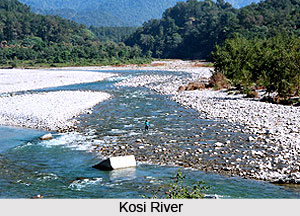 Geography of Darbhanga includes four subdivisions land vast areas of alluvial plains and does not possess hilly regions. The total area of Darbhanga district measures about 2, 279 square kilometers. Darbhanga`s eastern portion comprises Biraul, Ghanshyampur and Kusheshwarsthan and these regions are filled with fresh deposits of silt which had been collected by Kosi River. Floods in the River Kosi greatly affected these areas till the Kosi embankment was constructed as part of the Second Five Year Plan. Wild marshes cover huge areas of sandy land. The most fertile portion of Darbhanga is the area which is present in the southern part of Budhi Gandak River. Rabi crops grow quite well here. The area of Doab which is present near the rivers of Burhi Gandak and Bagmati is another important fertile tract of land in this district. The Sadar subdivision is the fourth part of Darbhanga. Several streams irrigate these areas of land.
Geography of Darbhanga includes four subdivisions land vast areas of alluvial plains and does not possess hilly regions. The total area of Darbhanga district measures about 2, 279 square kilometers. Darbhanga`s eastern portion comprises Biraul, Ghanshyampur and Kusheshwarsthan and these regions are filled with fresh deposits of silt which had been collected by Kosi River. Floods in the River Kosi greatly affected these areas till the Kosi embankment was constructed as part of the Second Five Year Plan. Wild marshes cover huge areas of sandy land. The most fertile portion of Darbhanga is the area which is present in the southern part of Budhi Gandak River. Rabi crops grow quite well here. The area of Doab which is present near the rivers of Burhi Gandak and Bagmati is another important fertile tract of land in this district. The Sadar subdivision is the fourth part of Darbhanga. Several streams irrigate these areas of land.
Four main rivers, namely, Kamala River, Baghmati River, Tiljuga River, and Little Baghmati River are adequate sources of water for Darbhanga district. Besides these rivers, many other Himalayan rivers water this region. Baghmati River originates from the district of Muzaffarpur and enters Darbhanga and it acts as a boundary between Samastipur and Darbhanga district. Thereafter this river joins the Burhi Gandak River near the area of Rosera. Kamla River flows across Darbhanga at the place called Singar Pandaul. This river joins Tiljuga River at the south-eastern part of the block of Rosera. Little Bagmati River flows through Madhubani district near Pali.
Dry climate is a distinct characteristic of Darbhanga district. Winter season commences in the month of November and lasts till February. Generally, monsoons, winter and summer season are the main seasons of the district. The month of March is characterized by a pleasant climate. During March, westerly winds start blowing in the second half of March. Therefore at this time, the temperature shoots up to a great extent. During the month of May, the temperature rises up to over 42øC and rains arrive in June. Humidity is at its maximum, especially in monsoons. The rainy season continues till August. However, till October, Darbhanga experiences moderate rainfall. The average rainfall which occurs here is approximately about 1142.3 mm. Nearly 92% of aggregate quantity of rainfall takes place in monsoons.



















